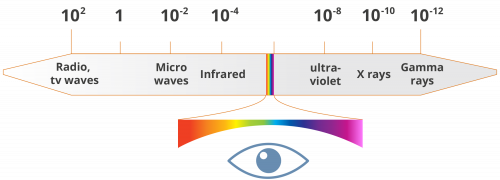Although very distant from our planet (~ 150 million km on average), the Sun provides us with light energy and heat, both necessary to sustain life on Earth.
This energy arrives in the form of electromagnetic radiation, which is wave-like in nature and therefore is characterized by a wavelength related to the composition and temperature of the transmitter, in this case, the Sun.
Different rays electromagnetic spectrum
The electromagnetic spectrum describes the distribution of the different types of radiation over a wide wavelength spectrum.
In descending order of wavelength, the spectral range extends from radio waves (long wavelengths) up to tiny gamma rays (small wavelengths), with the infrared (IR), visible and ultraviolet (UV) ranges in between, where the Sun emits the most of its radiation.
- Our human eye is only sensitive to a small fraction of the solar spectrum called the "visible" (between 4 x 10-7 m and 7 x 10-7 m) that includes all colors of the rainbow (from violet to red).
- Just below this range, between 1.0 x 10-7 m and 4 x 10-7 m, we find the ultraviolet rays (UV), especially energetic but invisible to the human eye
- Beyond the visible and longer than 7 x 10-7 m, infrared wavelengths begin. This range is associated with the concept of heat as hot objects emit such radiation.
Fortunately the atmosphere is acting as a protector shield against dangerous gamma rays, X-rays and the major part of UV because all of them are particularly harmful.
UV-A, UV-B & UV-C wavelength
UV rays are subdivided in three bands, depending on their energetic level:
| Range | Wavelength bands | Hazards for life on Earth |
|---|---|---|
| UV-A | 315-400 nm | Benign effects. Nevertheless, UV-A represent 98% of global UV flux on Earth. |
| UV-B | 280-315 nm | Particularly dangerous. Fortunately UV-B represent only 2% of the overall flux on Earth. |
| UV-C | 100-280 nm | Totally absorbed by the atmosphere, UV-C does not reach the Earth’s surface. |
A nanometer (nm) is equal to 10-9 m.


